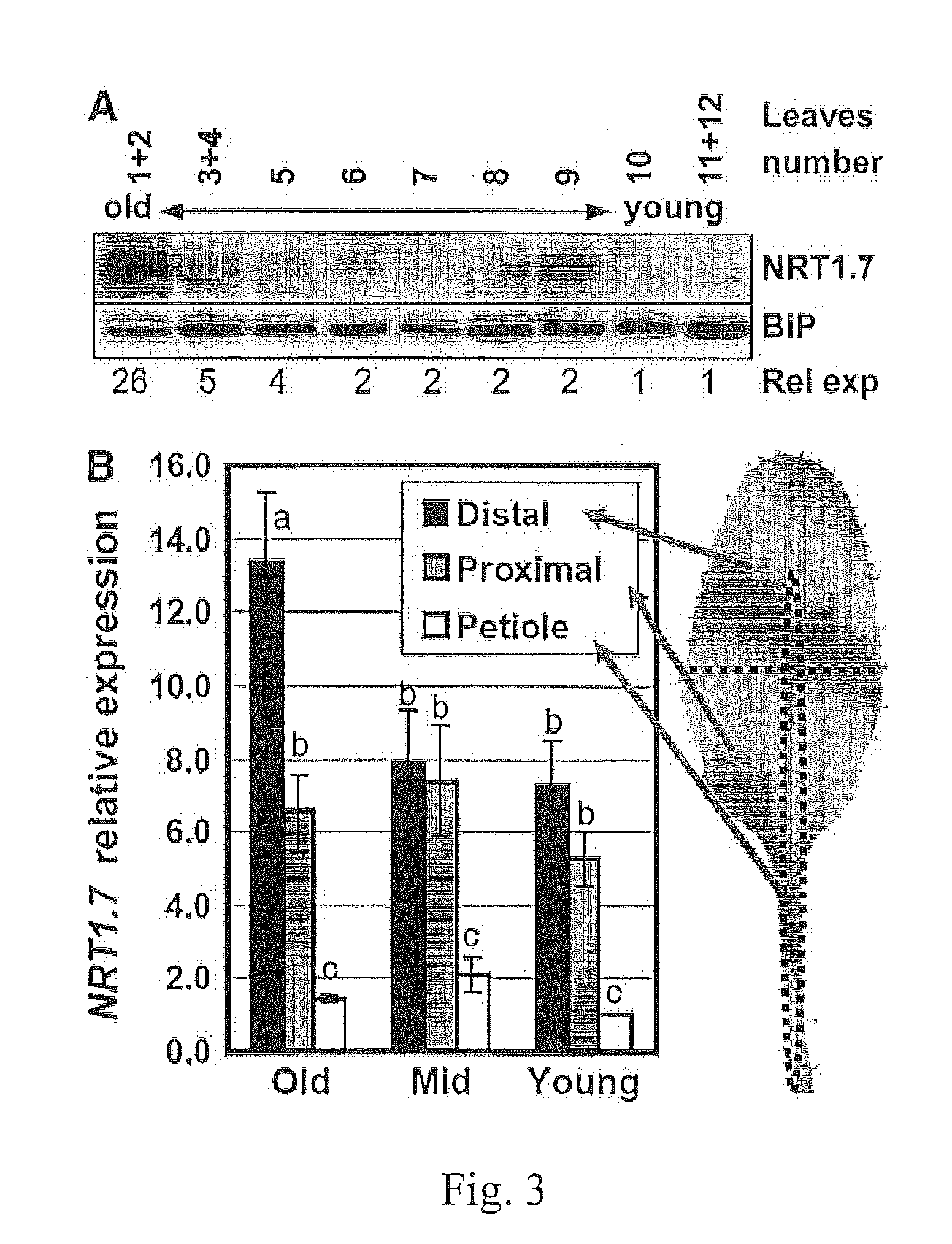Method for changing nitrogen utilization efficiency in plants
a technology of nitrogen utilization efficiency and plant, which is applied in the field of changing nitrogen utilization efficiency in plants, can solve the problems of nitrogen fertilizer being one of the most expensive nutrients to supply, and achieve the effects of enhancing plant growth, high or low expression, and changing nitrogen utilization efficiency
- Summary
- Abstract
- Description
- Claims
- Application Information
AI Technical Summary
Benefits of technology
Problems solved by technology
Method used
Image
Examples
example 1
NRT1.7 Encodes a Low Affinity Nitrate Transporter
[0084]In Arabidopsis, there are 53 NRT1 (PTR) genes, some of which are known to transport nitrate, while others transport dipeptides. To determine the substrate specificity of NRT1.7, in vitro-synthesized cRNA was injected into Xenopus oocytes for electrophysiological analysis. After 2-day incubation in ND96, oocytes were voltage clamped at −60 mV, and then subjected to 300 ms voltage pulses from 0160 mV in −20 mV increments. NRT1.7-injected oocytes responded to 10 mM nitrate at pH 5.5 with inward currents. And the inward currents were elicited by nitrate but not by the dipeptides tested (FIG. 1A). The current elicited by nitrate was pH-dependent, with little or no current detected when exposed to nitrate at pH7.4. The pH dependence of the nitrate elicited currents suggested that NRT1.7 is a proton-coupled nitrate transporter.
[0085]Most of the nitrate transporters in NRT1 (PTR1) family function as a low-affinity transporter with excep...
example 2
NRT1.7 is Expressed in Phloem Tissue of Old Leaves
[0086]Microarray data from the public resource A. thaliana Expression Database CSB.DB shows that little or no expression of NRT1.7 can be detected in root, and that transcription levels in leaves increased as leaves age (FIG. 2). The differential expression of NRT1.7 in old and young leaves was further confirmed here by Western Blot analysis (FIG. 3A). Using BiP as loading control, the NRT1.7 protein level in the oldest leaves was about 25 times higher than that in the youngest leaves. In addition, the leaves were separated into distal lamina, proximal lamina, and central part including midrib and petiole for quantitative RT-PCR analysis. The NRT1.7 mRNA level was higher in the distal lamina of older leaves (FIG. 3B).
[0087]To determine where NRT1.7 is expressed, 13 independent transgenic lines expressing GUS driven by NRT1.7 promoter were analyzed. Consistent with Western Blot result, GUS staining was stronger in the older leaves, wh...
example 3
NRT1.7 is Localized to the Plasma Membrane
[0089]To investigate the subcellular localization of NRT1.7, green fluorescent protein (GFP) fused either N-terminally or C-terminally to NRT1.7 was transiently expressed in Arabidopsis protoplasts under the control of the cauliflower mosaic virus 35S promoter. Green fluorescence was seen in cytoplasm in the GFP control, while the green fluorescence of NRT1.7-GFP and GFP-NRT1.7 (FIG. 5) was detected as a fine ring at the cell periphery, external to the chloroplasts, indicating that NRT1.7 is localized in the plasma membrane.
PUM
| Property | Measurement | Unit |
|---|---|---|
| pH | aaaaa | aaaaa |
| time | aaaaa | aaaaa |
| pH | aaaaa | aaaaa |
Abstract
Description
Claims
Application Information
 Login to View More
Login to View More - R&D
- Intellectual Property
- Life Sciences
- Materials
- Tech Scout
- Unparalleled Data Quality
- Higher Quality Content
- 60% Fewer Hallucinations
Browse by: Latest US Patents, China's latest patents, Technical Efficacy Thesaurus, Application Domain, Technology Topic, Popular Technical Reports.
© 2025 PatSnap. All rights reserved.Legal|Privacy policy|Modern Slavery Act Transparency Statement|Sitemap|About US| Contact US: help@patsnap.com



